HOME GARDENS DESIGN-SKY GARDENS ROOF DESIGN

Asphalted streets, sealed the earth beneath our feet, tall buildings built tightly, preventing the horizon made to look, urban grass, making the sun radiation in the ... Concrete aesthetics of cities, which for years convinced us that it is a symbol of human development, has lost its charm. As dependent on urbanization to become man, he is no way to recognize yourself in the endless rows of metal and glass. Therefore increasingly looking for a way to spiritual living space, while surrounding with small spots and nature and plants that have not lost the ability to bring peace, balance and positive energy.
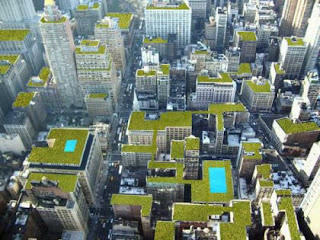
And as in big cities every available piece of land is a future building, gardens and parks had to find another form of existence ... and so they settle on the roofs.
In fact, roof gardens are not invented by modern man - everyone has heard about 7 - they are miracles of the world, which include the Hanging Gardens of Semiramis, but today it is one of the few options to improve conditions and environment in which live.
Modern systems for roof landscaping are relatively new - they were developed in Germany in 1960. To date, calculations show that about 10 percent of roofs in Germany have been turned into gardens.
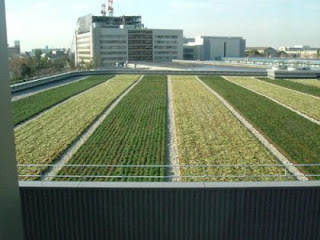
Besides the aesthetic aspect, roof greening is a chance for cities to acquire more humanity and to regain at least part of its initial purity.
Besides the notion roof garden, this phenomenon may be encountered as a "green roof, green roof or a" living "roof. To them, however, does not include plants grown in pots.
Tasked to examine the importance of green roofs loan organization "Green roofs for healthy cities", based in Toronto by Stephen Peck. Traditional building materials absorb solar radiation and then returned in the form of heat, leading to a rise in temperature in cities with whole 7 degrees. After lengthy observations and experiments it is concluded that the creation of green roofs can successfully reduce the impact of global warming and increased ambient temperature. It is estimated that if the roofs in major world cities become "green" values of urban temperatures will fall to around 12 degrees.
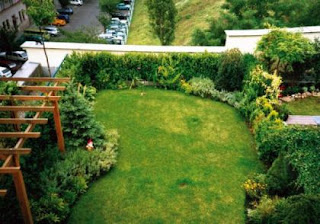
Another study conducted by Environment Canada indicates that the presence of  «zelen» roof saves 26% of cooling in summer and in winter heat losses reduced to 25%. Moreover, the planting of cover extended his life by 2 to 3 times as the roof structure is protected under special layers. Thus also achieved excellent waterproofing and sound insulation.
Lastly green roofs provide a viable environment for many plants, beneficial insects and animals that otherwise difficult to survive in the concrete cities, but which are important for biological equilibrium. According to the monitoring even buildings with a height of 19 floors, attract bees, roof gardens, butterflies, insects and birds.
In the United States in many areas with high rainfall,  «zelenite» roofs are one of the options for flood prevention. It is proven that they take up to 75% of rainwater and thereby prevent the transfusion of combined systems for drainage of rainwater. Moreover, the water that remains in the drainage part of them, is purified from the accumulated pollutants and heavy metals is through evaporation back into the atmosphere. That is one reason the legislation in the country to encourage and assist investors and entrepreneurs who implement projects with green roof areas.
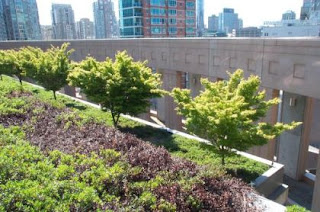
Like everything else, and green roofs differ. But the most common lines can be categorized into three groups - intensive, semi intensive and extensive. Ð azdelenieto be done according to the depth of soil layer used, the types of plants that are grown and the conditions they need it.
Classical garden, which we used to see in parks and yards, may be realized on the roof of a building. In this case it is called intense, because in it the amount of soil per square meter over 300 kg. This makes it possible to be planted trees, shrubs and other types of flowers and grasses, which achieved spectacular storey planting. Intensive green roofs require the most care and regular maintenance to be well-shaped foliage.
In the semi - intensive green roofs amount of dust per square meter is between 100 and 300 kg and a thickness of between 10 and 22 cm
Extensive roofs are designed so as to be self-sustaining. They have a thin layer of soil or compost, which are grown on low-stemmed plants with shallow root system. Even placing a thin mineral wool for base and top few centimeters of soil allows the cultivation of plant species of the genus Sedum / Debeletz Casa sedum /, herbs, spices and mosses. Such a green roof requires care no more than 1-2 times a year - for fertilization and eventually podkastryane.
According to the type of roof can be done and another division - pitched roofs and flat green ones. Pointed green roofs are traditional buildings in Scandinavia - they usually have a strong simple design compared with flat roofs. This is because on a sloping roof is difficult to achieve good drainage, which increases the risk of infiltration of water into the roof structure.
Whatever the type of cover, however, when landscaping is required the participation of specialists. In the most general terms, the main components of green roof system are: - geotextile, which is in the form of polypropylene webs, which are resistant to chemicals in soil and mildew and pests. They do not decompose.
-drainage panel, often made of rigid material such as polystyrene. The panel has the tanks, which hold water in the garden, and leads to excess drainage system.
- The barrier for the roots that is used is a polypropylene sheet with a thickness of several centimeters. It inhibits the growth of roots and growth of bacteria and microorganisms living in soil.
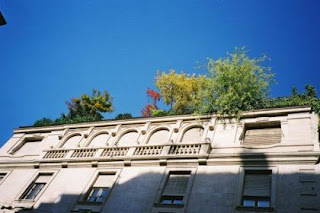
vlagozadarzhashtata-pad is made of synthetic fibers, whose function is to retain moisture, which is necessary for plant life.
According to the ranking of cities with the most monogo green roofs in America, conducted by "Green Roofs for Healthy Cities", the top positions are occupied by Chicago, Washington, Uaylduud, Dulce, Kansas, Phoenix, Milwaukee, New York and Portland. One of the most impressive roof garden is located on the building of the Ford Motor Company in Michigan, where nearly 42.000 square meters are covered with vegetation. Other known buildings in this respect are the Chicago `s City Hall and the Gap Headquarters in San Bruno, California.
One of the favorable trends in this direction is the planting of cover not only residential buildings but also the industrial and public ones. The idea is to create a miniature eco-systems in which to grow rare species of plants, animals and insects. A similar example of this is "Laban" - the center for modern dance in London, with a green roof provides shelter to rare and endangered birds Black Redstar. For this project, in 2003, "Laban" won the RIBA / Royal Academy of Architecture /.
The first botanical garden roof, called International Green Roof Institute / IGRI / is in Augustenborg, a suburb of Malmö / third largest city in Sweden /. It was established in 1999 and its official opening to the public was in 2001. Its function is as a research and education.
source:www.sgrada.com




